Why Do So Many Climbers Not Wear Helmets?
This article originally appeared on Climbing
This article was originally published in 2013 and has been updated where relevant—Ed.
Beth Rodden didn’t expect trouble on the Central Pillar of Frenzy on Yosemite’s Middle Cathedral Rock. After all, the 33-year-old superstar had free climbed the Nose of El Cap and put up the Valley’s hardest crack climb, the then-unrepeated 5.14c Meltdown. One of the best female rock climbers on the planet, she had never been injured in a climbing fall. Rodden devoured routes like the Central Pillar without breaking a sweat.
But this mega-popular 5.9 would serve as a reminder of one of climbing’s greatest risks--and also a leading appeal of the sport: that anything can happen, anywhere, anytime, without warning, even on the most familiar terrain. Partway through the first pitch on the Central Pillar, Rodden’s foot slipped on polished granite, flipping her upside-down and into a freefall. Twenty feet down, going approximately 23 mph, the back of her head slammed into rock.
At first, Rodden says, “I didn’t think I was hurt. We actually climbed the rest of the day. But the next night at dinner, I was having a really hard time concentrating. I could see [people talking], but I couldn’t process what they were saying.” Another red flag: Rodden’s forehead was sore, even though she’d hit the opposite side of her head. The next day she went to her doctor, who explained that her brain had slammed forward against her skull upon impact with the rock face. Diagnosis: concussion.
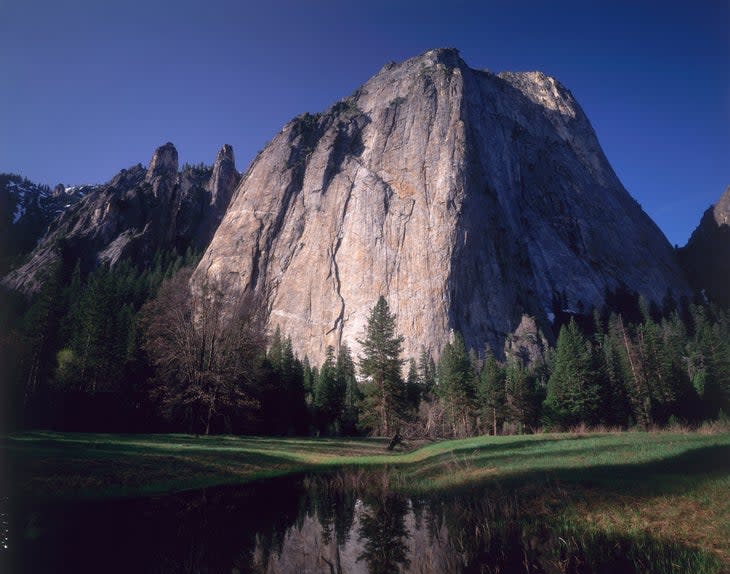
Concussion is only one of many serious head injuries a climber might suffer--others include skull fractures and severe lacerations--but new awareness of concussions’ frequency and their potential long-term effects has caused consumers, manufacturers, and regulators to re-examine many sports and their protective equipment. High-tech anti-concussion helmets are making their way into the cycling and skiing markets, and President Obama declared that if he’d had a son, he might not allow him to play football because of the latest research on traumatic brain injuries. One study, from the Annals of Otology, Rhinology & Laryngology journal, found that an estimated 5,067 patients suffered head and neck injuries from rock climbing nationally from 2009 to 2018. Concussion and closed-head injury was the most common injury at 44 percent. Indeed, there is little doubt that Rodden’s experience could happen to anyone.
Rodden says her recovery was slow, and she wonders if the concussion is to blame when she has trouble concentrating even today. The symptoms of traumatic brain injury can last for weeks or months--and multiple concussions can cause years of problems. The accident caused Rodden to rethink her stance on climbing helmets. “I hardly ever wore a helmet while climbing in Yosemite, but now I always try to wear one, even if the route is easy,” she says.
Climbing Magazine is now 50% off for a limited time. Just $24 a year gets you five print issues (four Climbing, one Ascent) delivered to your door. Subscribers also receive unlimited access to over 5,000 articles on climbing.com.
But sometimes, especially when the climbing is hard, Rodden chooses to leave her helmet behind. When we spoke, she was in Spain for sport climbing on overhanging limestone, and she hadn’t even packed a helmet for the trip.
When it comes to helmets and climbers, inconsistency is everywhere. Most ice climbers and mountaineers wear helmets, as do many traditional rock climbers. But far fewer rock climbers don lids for short climbs, especially sport routes. (Though you can’t rule it out, you’re much less likely to smack your head or suffer rockfall on an overhanging 5.12 sport climb, at the Red River Gorge, Kentucky, for example, than you are on a ledge-filled 5.8 in Eldorado Canyon, Colorado.) Many ice climbers forego their helmets while rock climbing. Some climbers wear a helmet to one crag but not to another. Or they’ll wear it while leading but not while belaying. And given the track record in cycling--around half of all cyclists still don’t always wear helmets, despite a great toll of head injuries--this is not likely to change. Most climbers will continue to make day-by-day decisions about their helmets.
On the surface, this seems nuts. If helmets prevent or mitigate head injuries, shouldn’t a climber always wear one, from the second she arrives at the crag to the moment she starts hiking back to the car? Or is helmet use, like so many aspects of our sport, an issue that resists pat answers?
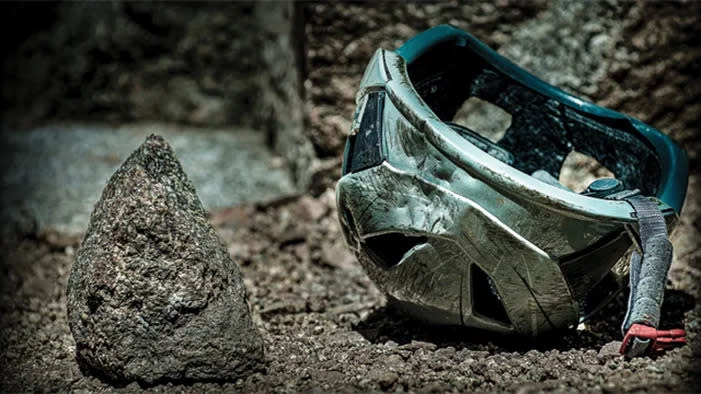
Head injuries, though rare in climbing, are potentially catastrophic.
On a spring day in 2008, Evie Barnes, a 21-year-old boulderer, started up her first trad route, the long, easy east face of the Second Flatiron in Boulder, Colorado. Near the top, her partner asked if she’d like to lead a short step. Barnes fell partway up the pitch, popping out her naively placed pro, and tumbled down the slab. She sprained both ankles, strained a knee and thumb, and chomped a big chunk out of her tongue. Before she came to a stop, she smacked the side of her head just above her left ear against a big flake of conglomerate sandstone.
Barnes was in shock, but other climbers helped her get to the trail and walk down the mountain to her car. She didn’t go to the doctor right away, but then, a couple of days after the fall, a friend told her she was acting “weird.” Barnes says, “I’ve never been much of a crier, but I started randomly crying on my way to work.” A round of visits to neurologists and other specialists soon began. Though no evidence of injury showed up on MRI or CT scans, Barnes began suffering migraines. Her speech slowed, and her motor skills deteriorated. “If I was eating, my fork would just sit there; I couldn’t bring it to my mouth,” she says. “And my legs would crumple beneath me while I was walking.”
Barnes was diagnosed with post-concussive syndrome, a series of symptoms associated with brain injuries, and five years later she’s still trying to find her way back to a full recovery. “My neurologist put me on a seizure medication that helped my migraines but made me act like I was drunk. It was embarrassing,” Barnes says. She tried craniosacral therapy and massage. “Life was doable, and I could work a part-time job, but I never got the energy back that I used to have.”
Last fall, she banged her head against a low ceiling, and some symptoms returned. (Victims of repeated concussions are particularly vulnerable to long-term problems.) Now she’s undergoing hyperbaric treatments, breathing 100 percent oxygen in a chamber for 70 minutes a day. Unable to work full-time, she helps clean the hyperbaric business to pay for treatments she can’t afford. But she’s begun climbing again. “It took a lot of adjustment, because just like with the fork not being able to get to my mouth, my hands didn’t want to move to the next hold,” she says. “I’m definitely not as strong as I was before, and I’m way more cautious. But I’m starting to feel like I can actually train again.”
Luckily for climbers, injuries like Barnes’ are unusual. High-altitude mountaineering is more dangerous: If you venture above base camp on Annapurna, you’ve got about a 1 in 25 chance of dying. By contrast, fatalities in rock climbing and bouldering are very uncommon. Statistically, rock climbing is nowhere near as dangerous as the mainstream media (or your mom) would believe.
[Read: Is Trad Climbing More Dangerous Than Sport Climbing? What 30 Years of Accident Data Tells Us.]
An average of about 30 climbers of all disciplines die each year in the United States, from falling, rockfall, or any other cause--about the same number of skiers and snowmobilers, combined, killed by avalanches annually in the U.S. Compare this with cycling, which kills 600 to 800 riders a year and injures more than 40,000 in the United States--a greater rate of deaths per participant than in climbing. A parent or nurse might argue that 30 deaths is still an unacceptably large number, but compared to other sports perceived as less dangerous, rock climbing is statistically quite safe.
In fact, the huge majority of climbing injuries are non-traumatic--finger and elbow tendonitis, shoulder pain, and similar overuse injuries--or cuts, sprains, broken bones, and other non-life-threatening injuries, mostly in the lower extremities. In 2009, the American Journal of Preventive Medicine published a study by Nicolas Nelson and Lara McKenzie of U.S. Consumer Product Safety Commission data on climbers admitted to emergency rooms. Injuries to the lower extremities accounted for nearly half of the climber ER visits between 1990 and 2007, with ankles bearing the brunt of the damage. In the same study, head injuries (including neck, face, eyes, ears, and mouth) accounted for 12 percent of the total--an average of about 275 a year. (There was no data on who wore a helmet.) Other studies and surveys have shown a 4 to 8 percent rate of head trauma among all climber injuries.
The actual total of head injuries is likely considerably higher than these studies suggest. Some surveys included tendonitis and other non-emergency injuries, and the Nelson-McKenzie study did not account for injured climbers who saw a non-emergency physician (as Rodden and Barnes did), nor did it track fatalities. We also do not know the numbers of unreported head injuries--climbers who took a blow to the head but never saw a doctor.
An average of about 30 climbers of all disciplines die each year in the United States, from falling, rockfall, or any other cause--about the same number of skiers and snowmobilers, combined, killed by avalanches annually in the U.S.
Meanwhile, there’s no doubt that head injuries, though relatively uncommon, often are radically different from other climbing maladies. Inflamed tendons are frustrating and painful, but they rarely require significant medical intervention; broken bones seldom demand hospital stays. By contrast, a quarter of the head injuries in the 2009 survey--more than twice the rate for all climber ER visits--resulted in hospitalization. And as Evie Barnes’ experience shows, the consequences of head impacts can stretch over years.
“Every single doctor said, ‘You should have worn a helmet,'” Barnes says now. “They said I probably still would have gotten a light concussion because I hit so hard, but they had no doubt that if I had a helmet, I would have been way better off.”
Rock climbers wear helmets in some settings but not others.
Not long ago, very few climbers wore helmets, even in the most dangerous situations. Pioneering alpinist and gear maker Yvon Chouinard climbed perilous ice and alpine routes with his head clad only in a yellow-and-purple knit hat. “When I started climbing 25 years ago, it wasn’t cool to wear a helmet,” says Dan Middleton, chief technical officer at the 65,000-member British Mountaineering Council (BMC), which has done extensive helmet research and education. “You’d very rarely see people [using them while] crag climbing. Now that’s changed.”
The vast majority of ice climbers and alpinists wear helmets. But among rock climbers, helmet use varies widely depending on where and how you climb. In a survey of 1,887 rock climbers published in Journal of Trauma in 2006, 36 percent reported wearing helmets most or all of the time, while 19 percent never wore helmets; the rest sometimes or seldom wore them. Another survey of 1,400 rock climbers, completed in 2012 by Kevin Soleil, then a master’s student at the University of Tennessee, Knoxville, found similar patterns. The percentage of respondents who said they usually or always wore a helmet was 49 percent among sport leaders, 53 percent for topropers, and 86 percent for leaders on traditional climbs.
Look around a typical American crag, and Soleil’s numbers will likely seem high. (He cautions his results may be skewed because he did not survey climbers under 18--the mean age in his survey was 36, and younger climbers tend to wear helmets less often than older ones.) Based on multiple observations of sport and traditional crags in Colorado, helmet usage was lower across the board. In Boulder and Clear Creek canyons, at five mid-difficulty sport climbing crags, about 35 percent of leaders were wearing helmets. Less than 20 percent of belayers wore helmets, and only 10 percent of people standing or sitting under climbs wore them. Down the road in Eldorado Canyon, a traditional area known for loose rock and tricky protection, 66 percent of leaders wore helmets, and 45 percent of belayers were helmeted.
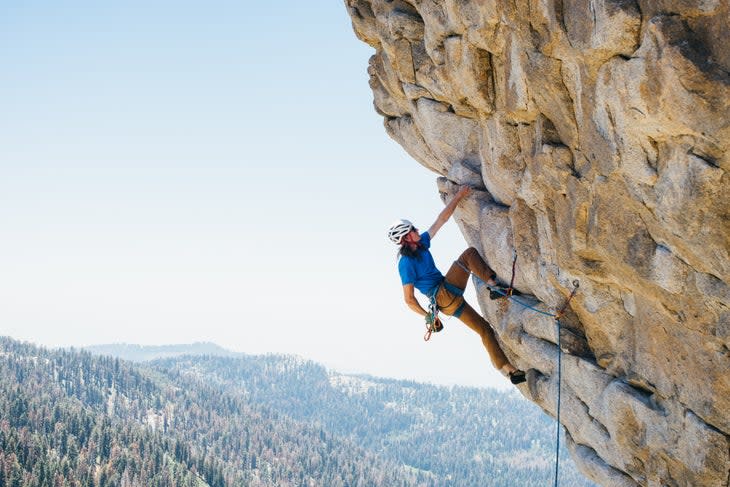
Unsurprisingly, Soleil’s survey suggests that as climbs get steeper and the difficulty higher, especially on sport routes, fewer people wear helmets. Generally, overhanging climbs are less vulnerable to rockfall and impacts with the rock. Chris Weidner, who says a helmet saved his life after a 30-foot fall on El Capitan a decade ago, usually doesn’t wear one anymore for sport climbing. “I can’t think of anybody that sport climbs hard and wears a helmet,” he says. Rodden said during her trip to Spain, “I haven’t seen a single person here wearing a helmet.”
Virtually no one boulders with a helmet, despite the frequent bruising falls many boulderers take. One who does is the father of the bouldering V-grade and author of the Hueco Tanks guidebook, John “Verm” Sherman, who has had multiple concussions and now sports a helmet on highballs and even some butt-draggers. In a column at dpmclimbing.com, Sherman wrote, “These days, if I can’t find a legitimate reason not to wear a helmet, I wear one. Which is 98 percent of the time.”
You can also find rare instances of people climbing indoors with a helmet. Mark Dixon, 55, is an emergency room doctor in Loveland, Colorado, and a 5.12 leader, and every time he ties in to lead a route at the Boulder Rock Club, he also straps on his helmet. “I started wearing a helmet in the gym about a year ago,” he says. “I was taking a lot of falls, and twice in a week flipped upside down and whacked my head. It was nothing serious, but I thought, ‘This is stupid--I wear a helmet biking, climbing outdoors, and caving; why not wear one here, too?'”
For many climbers, the decision whether to wear helmets is not based on safety at all, but more around comfort and fashion. Soleil’s survey found that trad climbers were much more likely to say helmets were comfortable and “acceptable fashion.” Sport climbers were more likely to say a helmet was “unaesthetic” or uncool. (Typical negative comment: “I feel like I stand out at the crag.”) Soleil also found a significant correlation between climbers who don’t wear helmets and those who believe brain buckets “take away from the aesthetic look and feel of a climbing scene,” or that they “reduce performance.”
Though it’s rare, there are cases where a helmet negatively affects climbing performance. Most trad climbers can recount stories of removing a helmet to squeeze through a tight chimney. Helmets also can push your face away from the wall if you’re pulling in close for a delicate move. And for climbers who count the ounces of their quickdraws and choose sub-9mm ropes for redpoints, even a half-pound helmet may be too much to bear.
“A risk-based approach to helmets is what we’re pushing,” says Dan Middleton of the BMC. “We don’t want to just say, ‘Oh, you must wear a helmet.’ Climbing isn’t about rules. We want people to think about the risks and make their own decisions.”
Soleil’s study concluded that rock climbers make some logical risk-based decisions: They tend to wear helmets more often when they perceive greater threat from rockfall or climbs are less steep (thus a climber is more likely to impact something if he falls), and where routes are longer, poorly protected, or farther from medical care. However, the survey also reveals that some climbers make poorly reasoned decisions, including basing their choice on what’s “cool.” And across all types of rock climbing, fewer survey respondents wore helmets while belaying than while leading or following--despite the fact that falling rocks and dropped gear are at least as likely to hit you below a pitch as when you’re actually climbing it.
If you count ice climbers and mountaineers, climbers as a group still don’t wear helmets as often as participants in other head injury-prone sports. After rapid growth in the 1980s, the number of cyclists wearing helmets leveled out at around 50 percent, with the percentage rising as cyclists get older. The National Ski Areas Association reported that 61 percent of skiers and boarders wore a helmet in the 2010/2011 season, up from 25 percent in 2002/03. But among rock climbers, especially if you count belayers, boulderers, and people hanging out at the base of a cliff, fewer than half at any given crag are likely to be wearing helmets.
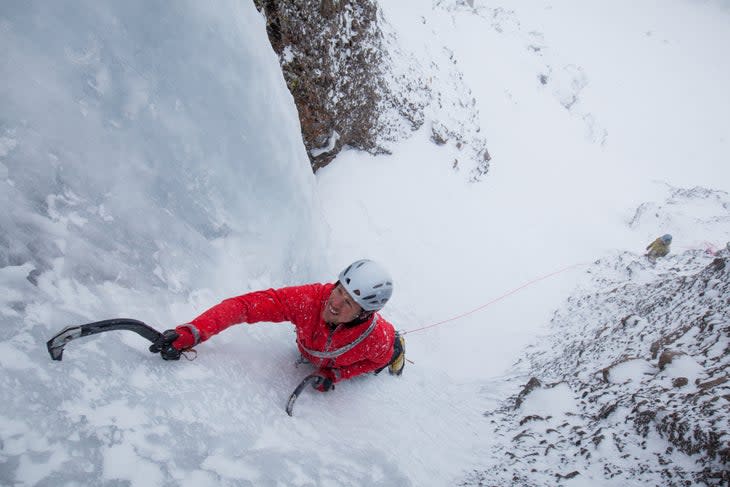
Climbing helmets are good at protecting against some types of impacts, but not others.
If every climber wore a helmet all the time, some would avoid life-altering brain injuries. But others would still be killed or disabled by head trauma. In early 2002, Rod Willard, an accomplished ice climber, was belaying behind the Fang in Vail, Colorado, when a block of ice estimated at 400 pounds broke off and hit him in the head. He was wearing a helmet, but he died instantly.
Rick Vance, technical information manager at Petzl America, explains that climbing helmets are considered Category 2 personal protective equipment, because they can’t guarantee protection against all risks they’re designed for. “A helmet can protect you against a golf ball-sized falling rock easily, but it cannot protect you from a microwave-sized block traveling at terminal velocity,” Vance says. “They’re called death blocks for a reason.”
Smart climbers are aware of helmets’ limits, and they focus more on avoiding blows to the head than fending them off with a thin skin of plastic and foam. Simple steps like avoiding climbing under other parties and placing protection frequently to avoid long falls will do much more to prevent head injuries than any helmet can.
There are even a few rare instances where helmets will increase your chance of injury: For example, it’s possible you could choke on the chinstrap if wedged into a chimney or crevasse after a fall. Straps on construction hard hats are designed to break for this reason, but climbing helmets are different--they have to stay on during a tumbling fall, and the straps are tested under load not to slip or break.
A less obvious hazard is what’s called risk homeostasis, the theory that says humans take more chances when they feel more protected. If donning a helmet entices you to attempt a 5.11 X face climb, are you really any safer?
In fact, it’s very difficult to prove that climbing helmets save lives at all, despite many anecdotes suggesting they do. On its website, Petzl has collected stories from climbers who swear helmets saved their lives. Reading these accounts, and looking at the photos of the busted helmets, you could easily conclude these climbers would be “dead for sure” if it weren’t for that trusty lid. But would they? Would a helmet have prevented Rodden or Barnes’ concussions?
“The answer is nobody knows,” says Christopher Van Tilburg, a mountain rescue and wilderness medicine expert who has worked for 14 years as a doctor at an emergency clinic on Mt. Hood in Oregon. “And the reason nobody knows is we can’t do a randomized, double-blind study on people wearing helmets.”
Numerous studies have shown that ski and bike helmets reduce the severity of injury in certain types of crashes. And though the data cannot prove that helmets save cyclists’ lives--because it’s impossible to say with certainty that a person would not have lived if he didn’t have a helmet--the fact that a very high percentage of fatal cycling accidents involve head injuries, and that most of the cyclists killed are not wearing a helmet--well, that’s a compelling set of statistics.
In 2007, the British Mountaineering Council surveyed nearly 500 climbers who had suffered head injuries, from minimal to severe. It concluded, “Wearing a helmet significantly reduces the chances of suffering a severe or major head injury: Non-helmet-wearers [were] more than twice as likely to suffer a severe head injury than helmet wearers.”
“Helmets probably don’t prevent death [among climbers],” says Dr. Van Tilburg. “Rock climbers die when they take huge falls and they have massive trauma. So the question is, are helmets useful for preventing head injuries? I would say absolutely yes, they are. The bigger the fall, the less the helmet is probably effective at preventing a concussion, and it doesn’t prevent what we call contrecoup injuries, where your brain moves inside your skull and bounces against the opposite side. But certainly, for a non-fatal fall, with a medium degree of impact, the helmet absorbs some impact.”
The influence of media and peer groups.
Magazines and other media also have a huge influence. Climbing occasionally gets letters from readers, like this one from New Jersey: “I like your magazine, but it is very troubling that so many of the photos depict climbers without helmets on. Does your organization recommend climbing without proper head gear?” The easy and obvious answer is that, no, Climbing doesn’t promote helmet-free climbing. Instead, the magazine’s photos reflect the current state of helmet use by climbers--Climbing shows the sport as it’s practiced today. In advertisements and videos, the vast majority of sponsored sport climbers and boulderers rarely wear a helmet. But imagine if Chris Sharma showed up in the next Reel Rock film slaying 5.15 routes in Catalunya with dirty-blond locks poking out from under the plastic brim of his helmet. Helmet use among sport climbers would skyrocket. No one says badass freestyle skier Kaya Turski isn’t cool because she wears a helmet. No one calls downhill mountain biking champ Aaron Gwin dorky because he protects his head. Why should climbing be different?
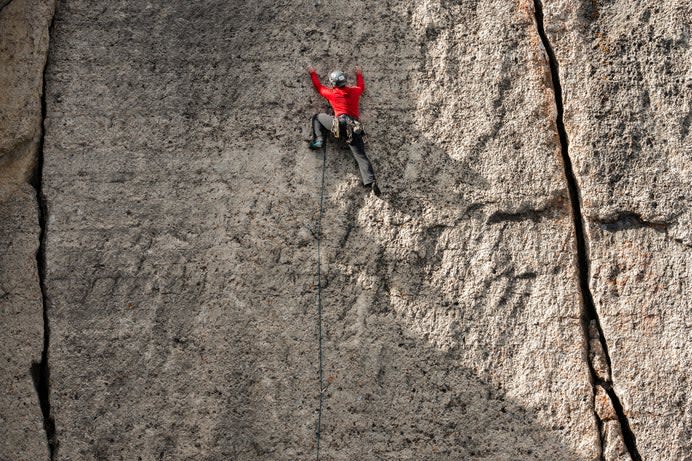
Every time we tie in, we make dozens of choices that could have serious consequences: Should I try this route? Do I trust this belayer or spotter? Can we finish the climb before it rains? Decision-making is integral to climbing’s appeal, and helmet-wearing is just one fraught choice in a long chain.
I believe if they thought seriously about the risks and benefits, more climbers would wear helmets. Someday, I believe, helmets will be a lot more effective than they are today. Meanwhile, like so many choices in climbing, helmet use comes down to very personal calculations. Here’s how I’ve made mine.
In more than 30 years of climbing, I’ve been hit in the head multiple times, usually while belaying ice climbs. Once I was dropped from the ceiling of my local gym, falling about 30 feet to the mat, where I rolled backward and smashed my head into a milk crate full of holds. I ended up with nine stitches in my scalp. If I’d hit the rigid corner of the crate, I might be dead. I can still feel the scar in the back of my head eight years later.
After that accident, I didn’t go full Mark Dixon and start sporting a helmet in the gym. But today, even though I know that helmets could be made stronger and safer, and although I understand it might not save my life, I always wear a helmet while leading, whether sport or trad. I am certain that I climb better with a helmet, with more confidence. And though I frequently don’t wear one for toproping or belaying, that’s changing, too. Some accidents in climbing are completely out of our control, but wearing a helmet is one easy thing I can do to gain a little power over my fate, without any special skills or effort. And I couldn’t face my wife if I chose to climb without a helmet, and then a falling rock or a tumble made me unable to earn a living, or talk to her, or feed myself.
Ultimately, it comes down to this: There are many climbs for which it’s perfectly reasonable to argue a helmet is not really necessary, but there are rarely good enough arguments for not wearing one. And so, more and more, I do.
Heads Up! How to Handle a Head Injury
Laceration
Signs and Symptoms (S/Sx): Cuts to the scalp are the most common head injury. Bleeding can be profuse.
Treatment (Tx): Check for more serious injury (like fracture). Firmly apply a bulky dressing. Consider tying the hair across the wound to act as a makeshift stitch. Apply ice to control swelling, if possible.
Evac? No
Skull Fracture
S/Sx: You find a depression or obvious crack, discharge from the ears or nose, or black and blue around eyes or ears.
Tx: Apply diffuse rather than direct pressure to stop bleeding (flow can relieve build-up and pressure in the skull). Stabilize spine and monitor airway, breathing, and circulation.
Evac? Yes
Closed Head Injury
S/Sx: If trauma causes brain swelling inside the skull, the brain becomes compressed. Did your partner lose consciousness? Watch for headaches, personality changes, altered vision, and dizziness.
Tx: Manage airway, breathing, and circulation. Wake up every few hours to assess level of consciousness.
Evac? Yes
In the days and weeks following head trauma, watch for symptoms indicating concussion: concentration and memory trouble, irritability, personality changes, light or noise sensitivity, problems sleeping, and depression.
Who Wears Helmets? Estimated Use by Climbing Discipline
Bouldering: <1%
Indoors: <1%
Sport: 35-50%
Outdoor toprope: 45-55%
Trad/multi-pitch/big wall: 65-85%
Alpine/mountaineering: 90%
Ice:>95%
Sources: “Helmet Use Among Outdoor Recreational Rock Climbers Across Disciplines: Factors of Use and Non-Use,” By Kevin Henri Soleil, 202; author field observation.
For exclusive access to all of our fitness, gear, adventure, and travel stories, plus discounts on trips, events, and gear, sign up for Outside+ today.

